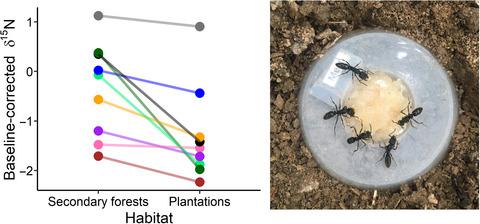当前位置:
X-MOL 学术
›
J. Anim. Ecol.
›
论文详情
Our official English website, www.x-mol.net, welcomes your
feedback! (Note: you will need to create a separate account there.)
Omnivorous ants are less carnivorous and more protein‐limited in exotic plantations
Journal of Animal Ecology ( IF 3.5 ) Pub Date : 2020-05-30 , DOI: 10.1111/1365-2656.13249 Toby P N Tsang 1 , Benoit Guénard 1 , Timothy C Bonebrake 1
Journal of Animal Ecology ( IF 3.5 ) Pub Date : 2020-05-30 , DOI: 10.1111/1365-2656.13249 Toby P N Tsang 1 , Benoit Guénard 1 , Timothy C Bonebrake 1
Affiliation

|
Diets of species are crucial in determining how they influence food webs and community structures, and how their populations are regulated by different bottom-up processes. Omnivores are able to adjust their diet flexibly according to environmental conditions, such that their impacts on food webs and communities, and the macronutrients constraining their population, can be plastic. In particular, omnivore diets are known to be influenced by prey availability, which exhibit high spatial and temporal variation. To examine the plasticity of diet and macronutrient limitation in omnivores, we compared trophic positions, macronutrient preferences and food exploitation rates of omnivorous ants in invertebrate-rich (secondary forests) and invertebrate-poor (Lophostemon confertus plantations) habitats. We hypothesized that omnivorous ants would have lower trophic positions, enhanced protein-limitation and reduced food exploitation rates in L. confertus plantations relative to secondary forests. We performed cafeteria experiments to examine changes in macronutrient limitation and food exploitation rates. We also sampled ants and conducted stable isotope analyses to investigate dietary shifts between these habitats. We found that conspecific ants were less carnivorous and had higher preferences for protein-rich food in L. confertus plantations compared to secondary forests. However, ant assemblages did not exhibit increased preferences for protein-rich food in L. confertus plantations. At the species-level, food exploitation rates varied idiosyncratically between habitats. At the assemblage-level, food exploitation rates were reduced in L. confertus plantations. Our results reveal that plantation establishments alter the diet and foraging behavior of omnivorous ants. Such changes suggest that omnivorous ants in plantations will have reduced top-down impacts on prey communities but also see an increased importance of protein as a bottom-up force in constraining omnivore population sizes.
中文翻译:

杂食性蚂蚁在外来种植园中较少食肉且蛋白质含量较高
物种的饮食对于确定它们如何影响食物网和群落结构以及它们的种群如何通过不同的自下而上的过程进行调节至关重要。杂食动物能够根据环境条件灵活调整饮食,因此它们对食物网和社区的影响以及限制其种群的常量营养素可以是可塑的。特别是,众所周知,杂食动物的饮食会受到猎物可用性的影响,其表现出很高的空间和时间变化。为了检查杂食动物的饮食可塑性和常量营养素限制,我们比较了无脊椎动物丰富(次生林)和无脊椎动物贫乏(Lophostemon confertus 种植园)栖息地中杂食性蚂蚁的营养位置、常量营养素偏好和食物开发率。我们假设杂食性蚂蚁在 L. confertus 人工林中相对于次生林具有较低的营养位置、增强的蛋白质限制和降低的食物开发率。我们进行了自助餐厅实验,以检查常量营养素限制和食物开发率的变化。我们还对蚂蚁进行了采样并进行了稳定同位素分析,以调查这些栖息地之间的饮食变化。我们发现,与次生林相比,在 L. confertus 种植园中,同种蚂蚁的食肉性较低,并且对富含蛋白质的食物有更高的偏好。然而,在 L. confertus 种植园中,蚂蚁组合并没有表现出对富含蛋白质的食物的偏好增加。在物种层面,不同栖息地的食物开发率存在差异。在组合水平上,L. 的食物开发率降低了。油棕种植园。我们的研究结果表明,种植园会改变杂食性蚂蚁的饮食和觅食行为。这些变化表明,种植园中的杂食性蚂蚁将减少对猎物群落的自上而下的影响,但也看到蛋白质作为自下而上的力量在限制杂食性种群规模方面的重要性增加。
更新日期:2020-05-30
中文翻译:

杂食性蚂蚁在外来种植园中较少食肉且蛋白质含量较高
物种的饮食对于确定它们如何影响食物网和群落结构以及它们的种群如何通过不同的自下而上的过程进行调节至关重要。杂食动物能够根据环境条件灵活调整饮食,因此它们对食物网和社区的影响以及限制其种群的常量营养素可以是可塑的。特别是,众所周知,杂食动物的饮食会受到猎物可用性的影响,其表现出很高的空间和时间变化。为了检查杂食动物的饮食可塑性和常量营养素限制,我们比较了无脊椎动物丰富(次生林)和无脊椎动物贫乏(Lophostemon confertus 种植园)栖息地中杂食性蚂蚁的营养位置、常量营养素偏好和食物开发率。我们假设杂食性蚂蚁在 L. confertus 人工林中相对于次生林具有较低的营养位置、增强的蛋白质限制和降低的食物开发率。我们进行了自助餐厅实验,以检查常量营养素限制和食物开发率的变化。我们还对蚂蚁进行了采样并进行了稳定同位素分析,以调查这些栖息地之间的饮食变化。我们发现,与次生林相比,在 L. confertus 种植园中,同种蚂蚁的食肉性较低,并且对富含蛋白质的食物有更高的偏好。然而,在 L. confertus 种植园中,蚂蚁组合并没有表现出对富含蛋白质的食物的偏好增加。在物种层面,不同栖息地的食物开发率存在差异。在组合水平上,L. 的食物开发率降低了。油棕种植园。我们的研究结果表明,种植园会改变杂食性蚂蚁的饮食和觅食行为。这些变化表明,种植园中的杂食性蚂蚁将减少对猎物群落的自上而下的影响,但也看到蛋白质作为自下而上的力量在限制杂食性种群规模方面的重要性增加。











































 京公网安备 11010802027423号
京公网安备 11010802027423号